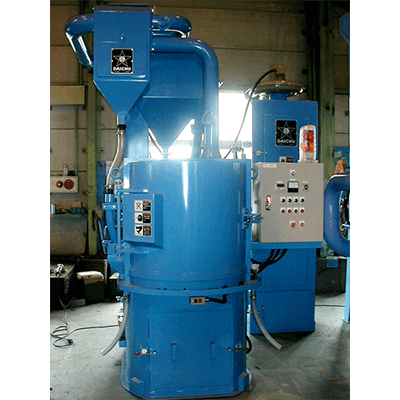What Is Blasting Equipment?

Blasting Equipment is a general term for devices that perform a surface treatment called blasting on a product or material.
Blasting refers to the process of shaving or creating fine irregularities on a product or material, such as metal, by projecting hard, fine abrasive particles of iron or sand at high speed and beating them against the surface of the workpiece.
There are several different types of blasting processes, and accordingly, several types of blasting equipment exists. Typical blast processes include sand blasting, shot blasting, and grit blasting.
Uses of Blasting Equipment
Blasting Equipment is used for surface finishing.
Specific applications include the following:
1. Polishing
Grinding the workpiece for surface finishing and deburring. By changing the abrasive projected onto the workpiece, it is possible to achieve a mirror finish or a pear-like finish.
2. Rust Removal
Rust on metal surfaces can be removed instantly. Since blasting is a physical process, it can remove rust not only from steel, but also from aluminum and copper.
3. Shot Peening
By impacting abrasive material onto the surface of the metal to be processed, compressive residual stresses act to harden the surface of the metal more. This leads to improved wear resistance and fatigue strength.
4. Paint Peeling
Paint can be stripped off by projecting abrasive material and grinding the surface of the workpiece. Blasting can be done by hand, but if the workpiece is large or bulky, it is generally blasted by blasting equipment.
In addition to the blasting method, there are many types of blasting equipment, such as table, hanger, drum, and rail types, depending on the object to be blasted and the number of pieces to be blasted. Therefore, it is important to select the most suitable blasting equipment according to the object to be blasted.
Principle of Blasting Equipment
1. Sandblasting (Airblasting) Equipment
Sandblasting equipment uses high-pressure compressed air to inject abrasive (silica sand, glass grains, etc.) for sandblasting. After impacting the object to be blasted, the abrasive is usually collected by a dust collector and used again as abrasive.
During the recovery process, the abrasive is generally separated from the dust and other powders that have been removed from the object to be blasted.
2. Shot Blast Equipment
Shot blast equipment projects abrasive by centrifugal force generated by a projector with an impeller rotating at high speed. The abrasive used in shot blasting equipment must be hard and of high specific gravity, such as iron, stainless steel, or zinc, and must be projected at high speed.
Therefore, shot blasting equipment must have such a mechanism. Also, since the abrasive being projected is hard and heavy, many of the objects to be treated are metals such as iron.
Features of Blasting Equipment
Blasting treatment, in which abrasive particles are projected directly onto the surface of the workpiece, has the following features:
1. Physical Processing Without the Use of Chemical Components
All blast processing methods do not use chemicals because the abrasive is projected onto the surface of the workpiece and physically polishes it.
2. Uniform Processing Is Possible
In the blast process, no other external forces are applied once the abrasive is injected. Therefore, by adjusting the mass, shape, and speed of the abrasive at the time of projection, the surface finish of the workpiece will be uniform.
Also, since a large amount of abrasive is used to polish the entire surface of the workpiece, it is possible to achieve a surface finish with no directionality compared to other types of polishing.
3. Any Material Can Be Used for the Workpiece
All methods of blasting are physical processes, so they can be applied to any material. It is possible to process a wide variety of materials, including metal, glass, stone, plastic, and wood.